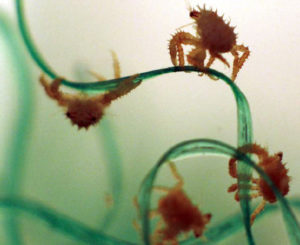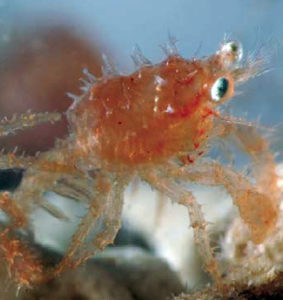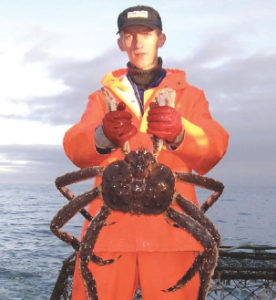Postlarvae, or glaucothoe, have limited abilities and are prone to cannibalism

The red king crab (Paralithodes camtschaticus) is one of the most important commercially harvested species of crustaceans, but a sharp decline of its stocks in the North Pacific Ocean has been observed during recent years. Therefore, it is important to not only reinforce existing management strategies, but also implement alternative approaches such as stock enhancement through aquaculture.
In nature, less than 1 percent of red king crab larvae survive to the postlarval stage. Culture techniques based on easily controlled and regulated rearing conditions that match the specific requirements of each developmental stage should make it possible to increase overall survival by dozens of times.
Artificial reproduction and subsequent culture followed by the release of early juveniles into the ocean are currently being considered as a possible way to red king crab stock enhancement. Laboratory culture is also helpful for improving knowledge on the early development of this species, which in turn assists in the establishment of resource management strategies. Research groups in several countries – Japan, the United States, Norway, and Russia – have been working on the improvement of culture methods for red king crabs.
Postlarvae study
The authors carried out larval culture experiments with red king crabs at the Crustacean Reproduction Laboratory of the Russian Federal Research Institute of Fisheries and Oceanography from 2002 to 2006. Among the main goals were to study the basic behavioral patterns of red king crab postlarvae (glaucothoe) and improve culture methods during different stages of early development.
The glaucothoes were reared in 80- to 160-l recirculating water tanks. Water temperature was maintained at 10.0 ± 0.5 degrees-C and salinity at 32 ± 0.3 g/l. The behavioral patterns studied included feeding, swimming behavior, photoresponse, and substrate preference. Photoresponse and substrate preferences were measured in specially designed and equipped experimental aquariums.
Results
Feeding
Comparative studies of the functional morphology of the oral appendages and anatomy of the digestive tracts, and behavioral observations of early life stages of the crabs confirmed earlier information that glaucothoes do not feed. They utilize internal lipid reserves accumulated during the larval phase and stored in midgut glands and a section of the digestive tract.
Locomotion
Locomotory behavior changes throughout the postlarval phase. For three days after molting, glaucothoes swim almost continuously using their pleopod abdominal appendages. Later glaucothoes remain largely inactive. They do not use pleopods for swimming and can not yet effectively use their walking legs. The reduced mobility of late glaucothoes likely reflects physiological changes that precede metamorphosis to the first juvenile instar, in which pleopods are rudimentary and do not function in locomotion.
Photoresponse

Early glaucothoes showed directionally oriented movement in response to light stimuli. Peak photoresponse in early glaucothoes was observed at 1.1 × 1010 quanta/cm2/second, as compared to the other 1.9×1013 and 1.3×109 quanta/cm2/second light intenstites tested. Late glaucothoes did not respond to light stimuli.
During mass culture, early glaucothoes tended to form dense groups in more illuminated areas of the tanks. This increased the probability of them being captured and consumed by highly cannibalistic individuals still at actively feeding larval stages or those that molted to the first juvenile instar, due to the asynchrony of moltings.
Therefore, blacking out the bottoms of transparent rearing tanks and even illumination of the tanks are recommended measures to favor even distribution of individuals and reduce the intensity of cannibalism, which is one of the main causes of mortality in red king crab culture.
Substrate preference
The substrate for rearing glaucothoes should be nontoxic, have texture that allows the glaucothoes to grab and hold it easily, and not impede cleaning procedures. The authors tested the suitability of two easy-maintenance artificial substrates: 0.5- × 0.5-mm nylon mesh screens and flat mats of plastic mechanical filter media. Each substrate was tested in two positions: horizontal and vertical.
About 79-84 percent of glaucothoes preferred the horizontally oriented mats of plastic filament, while horizontal nylon screens were chosen by 11 to 14 percent of the glaucothoes. The plastic mats provided a high degree of interstitial space and maximized the volume usage. They thus reduced the intensity of cannibalism and improved the effectiveness of culture.
Tranplanted crab population continues expansion

The red king crab is a boreal species with a broad distribution range in the North Pacific Ocean. The species is found from the Sea of Japan northward into the Sea of Okhotsk and along the shores of the Kamchatka Peninsula. In the northeast Pacific, distribution extends northward from the Queen Charlotte Islands of Canada to Norton Sound in the Bering Sea.
Through a transplantation project established by the Union of Soviet Socialist Republics in the 1960s, red king crabs were intentionally introduced into the Barents Sea. The crabs have since formed a viable, self-reproducing population that is now distributed along the Atlantic coasts of Russia and Norway, from the Geese Bank to the Lofoten Islands.
(Editor’s Note: This article was originally published in the March/April 2007 print edition of the Global Aquaculture Advocate.)
Now that you've finished reading the article ...
… we hope you’ll consider supporting our mission to document the evolution of the global aquaculture industry and share our vast network of contributors’ expansive knowledge every week.
By becoming a Global Seafood Alliance member, you’re ensuring that all of the pre-competitive work we do through member benefits, resources and events can continue. Individual membership costs just $50 a year. GSA individual and corporate members receive complimentary access to a series of GOAL virtual events beginning in April. Join now.
Not a GSA member? Join us.
Authors
-
Anna Epelbaum, Ph.D.
Fisheries and Oceans Canada
Pacific Biological Station
3190 Hammond Bay Road
Nanaimo, British Columbia V9T 6N7 Canada[97,99,46,99,103,46,111,112,109,45,111,102,100,46,99,97,112,64,97,109,117,97,98,108,101,112,101]
-
Rostislav Borisov, Ph.D.
Andrey Parshin-Chudin
Nikolina Kovatcheva, Ph.D.
Russian Federal Research Institute of Fisheries and Oceanography
Moscow, Russia
Tagged With
Related Posts

Aquafeeds
A look at protease enzymes in crustacean nutrition
Food digestion involves digestive enzymes to break down polymeric macromolecules and facilitate nutrient absorption. Enzyme supplementation in aquafeeds is a major alternative to improve feed quality and nutrient digestibility, gut health, compensate digestive enzymes when needed, and may also improve immune responses.

Intelligence
Adding flavor complexity to farmed barramundi
Organoleptic attributes such as flavor and aroma are among the most important factors that influence consumer acceptability and demand for fish products. Consumers have identified farmed fish as less complex and lacking “sealike” or “sea-fresh” flavors and aromas.

Intelligence
An inside look at Sino Agro Foods’ giant prawn MegaFarm
Sino Agro Foods has developed a proprietary recirculating aquaculture system that yields high production volumes and profitability. The facility should significantly contribute to seafood production in China and to help satisfy increasing demand for high value, safe and sustainably produced seafood.

Innovation & Investment
Artemia, the ‘magic powder’ fueling a multi-billion-dollar industry
Artemia, microscopic brine shrimp used as feed in hatcheries, are the unsung heroes of aquaculture. Experts say artemia is still inspiring innovation more than 50 years after initial commercialization. These creatures are much more than Sea-Monkeys.


